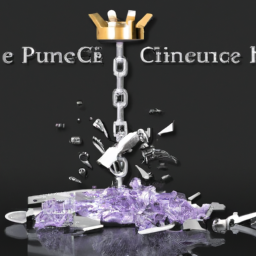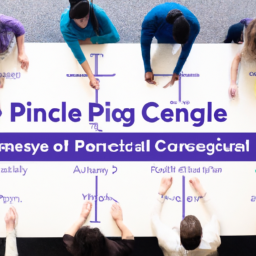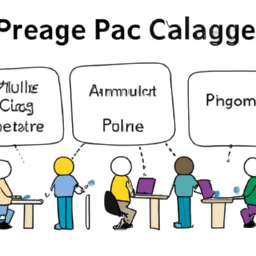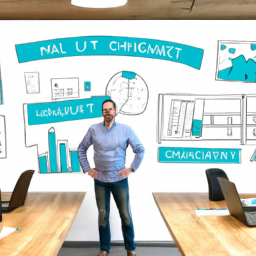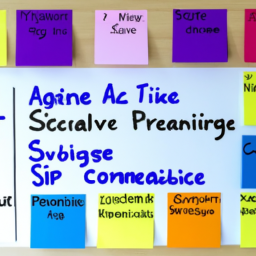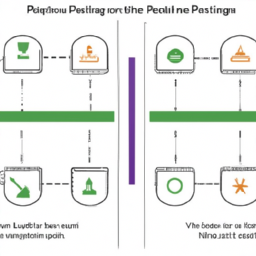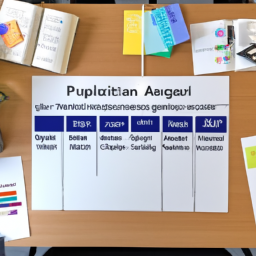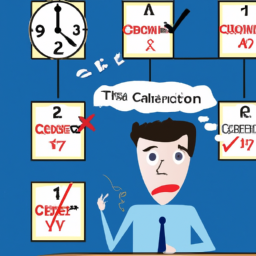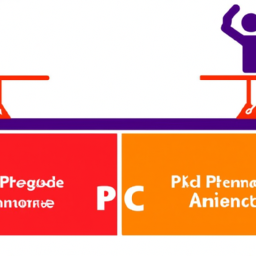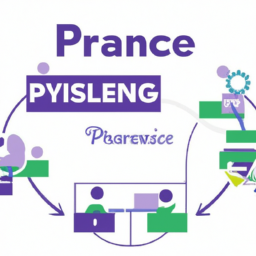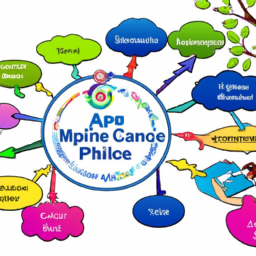Have you ever wondered if PRINCE2 Agile is truly worth the investment? Well, you’re about to uncover the hidden agenda behind this methodology.
In this article, we will provide you with a comprehensive overview of the evolution of PRINCE2 Agile, highlighting its key benefits and debunking the myths and misconceptions surrounding it.
Get ready to be inspired by real-life success stories and discover how organizations were transformed by implementing PRINCE2 Agile.
Finally, we will evaluate the return on investment (ROI) of this methodology, giving you the insights you need to make an informed decision.
Key Takeaways
- PRINCE2 Agile combines Agile flexibility with PRINCE2 structure
- Transitioning to PRINCE2 Agile requires a shift in mindset
- PRINCE2 Agile enables continuous improvement and issue resolution
- Evaluating the ROI of PRINCE2 Agile implementation is important
The Evolution of PRINCE2 Agile: A Comprehensive Overview
You’re probably wondering about the evolution of PRINCE2 Agile and what it entails. Well, let me give you a comprehensive overview.
PRINCE2 Agile is a project management methodology that combines the flexibility of Agile with the structure of PRINCE2. It was developed as a response to the increasing demand for organizations to adopt Agile practices while still maintaining a structured approach to project management.
The significance of PRINCE2 Agile lies in its ability to provide a framework that allows organizations to successfully implement Agile methodologies within a PRINCE2 environment. However, this integration does come with its own set of challenges.
One of the main challenges is finding the right balance between flexibility and control. Organizations need to ensure that they are not sacrificing the benefits of Agile by being too rigid with their project management processes. Transitioning from traditional project management to PRINCE2 Agile also requires a shift in mindset and a willingness to embrace change.
With this overview in mind, let’s now explore the key benefits of implementing PRINCE2 Agile methodology.
Key Benefits of Implementing PRINCE2 Agile Methodology
Implementing PRINCE2 Agile methodology brings numerous benefits to organizations. By combining the structured approach of PRINCE2 with the flexibility of Agile, this methodology allows organizations to effectively manage projects in a dynamic and ever-changing environment.
One of the key benefits of PRINCE2 Agile is its effectiveness in delivering projects on time and within budget. The iterative nature of Agile enables continuous improvement and allows for early identification and resolution of issues.
By promoting collaboration and communication between teams, PRINCE2 Agile ensures that everyone is aligned and working towards a common goal. This leads to improved productivity and higher quality deliverables.
Additionally, PRINCE2 Agile provides organizations with the ability to quickly adapt to changes, resulting in increased customer satisfaction and improved overall project success rates.
Unveiling the Myths and Misconceptions Surrounding PRINCE2 Agile
Unveiling the myths and misconceptions surrounding PRINCE2 Agile, it is important to understand the true value and benefits that this methodology brings to organizations. Many misconceptions exist about PRINCE2 Agile, but it is crucial to debunk these myths and focus on the facts. Let’s take a look at some of the common misconceptions and set the record straight:
| Misconception | Fact |
|---|---|
| PRINCE2 Agile is only for IT projects | PRINCE2 Agile is applicable to any industry or sector |
| PRINCE2 Agile is too rigid | PRINCE2 Agile encourages flexibility and adaptability |
| PRINCE2 Agile doesn’t work well with traditional project management | PRINCE2 Agile can be integrated with other project management methodologies |
Real-Life Success Stories: How PRINCE2 Agile Transformed Organizations
When organizations adopted PRINCE2 Agile, they witnessed remarkable transformations and achieved unprecedented success. The organizational impact of implementing PRINCE2 Agile can be seen through various case studies. Here are two examples:
-
Company A: By adopting PRINCE2 Agile, Company A was able to streamline their project management processes and improve collaboration between teams. This led to a significant increase in productivity and a reduction in project delays. The organization saw a 20% increase in customer satisfaction and a 15% increase in project success rates.
-
Company B: Prior to implementing PRINCE2 Agile, Company B struggled with adapting to changing customer requirements and maintaining project timelines. However, after adopting PRINCE2 Agile, they were able to embrace change more effectively and deliver projects on time and within budget. This resulted in a 25% increase in revenue and a 30% decrease in project failure rates.
These case studies highlight the positive organizational impact of implementing PRINCE2 Agile, demonstrating its value and effectiveness in achieving successful project outcomes.
Evaluating the Return on Investment (ROI) of PRINCE2 Agile Implementation
Are you curious about how organizations evaluate the return on investment of adopting PRINCE2 Agile?
When it comes to implementing PRINCE2 Agile, calculating ROI and measuring effectiveness are crucial factors.
Evaluating the ROI of PRINCE2 Agile implementation involves assessing the financial benefits gained from adopting the methodology and comparing them to the costs incurred during the implementation process. This assessment includes factors such as increased productivity, improved project success rates, reduced risks, and enhanced stakeholder satisfaction.
Measuring the effectiveness of PRINCE2 Agile implementation focuses on evaluating the achievement of project objectives, the level of collaboration and communication among team members, and the overall efficiency of project delivery.
Frequently Asked Questions
What Are the Specific Steps Involved in Implementing PRINCE2 Agile Methodology?
To implement PRINCE2 Agile methodology, you need to follow a series of specific steps.
First, assess your organization’s readiness for agile practices.
Then, tailor the PRINCE2 framework to fit your needs by selecting the appropriate agile techniques.
Next, create a project plan and define roles and responsibilities.
Implement agile practices by prioritizing and delivering work in iterations, using feedback loops, and adapting to change.
How Does PRINCE2 Agile Address the Challenges of Integrating Traditional Project Management With Agile Principles?
When it comes to integrating traditional project management with agile principles, PRINCE2 Agile addresses the challenges head-on. By combining the structured approach of PRINCE2 with the flexibility of agile, it provides a framework that allows for seamless integration.
This approach brings numerous benefits, such as improved collaboration, faster delivery, and increased adaptability. However, it’s important to note that there may be some drawbacks, such as the need for additional training and potential resistance to change.
Overall, the investment in PRINCE2 Agile is worth considering for organizations seeking a balanced and effective project management approach.
Are There Any Limitations or Potential Drawbacks to Implementing PRINCE2 Agile Methodology?
When considering the implementation of PRINCE2 Agile methodology, it’s important to be aware of its limitations and potential drawbacks.
While PRINCE2 Agile offers a unique approach to integrating traditional project management with agile principles, it may not be suitable for all organizations or projects.
Some limitations include the need for extensive training, potential resistance to change, and the challenge of balancing both methodologies effectively.
It’s crucial to carefully evaluate these drawbacks before deciding if the investment in PRINCE2 Agile is worth it for your specific needs.
How Does PRINCE2 Agile Support Collaboration and Communication Within Project Teams?
Prince2 Agile is a game-changer when it comes to collaboration and communication within project teams. It goes above and beyond to improve efficiency and enhance decision-making.
With its unique approach, Prince2 Agile fosters seamless interaction among team members, enabling them to work together harmoniously towards project success. It empowers individuals to share ideas, exchange feedback, and make informed decisions, resulting in a dynamic and productive work environment.
The benefits of Prince2 Agile in promoting collaboration and communication are truly remarkable.
Can PRINCE2 Agile Be Applied to All Types of Projects, Regardless of Industry or Size?
PRINCE2 Agile can indeed be applied to all types of projects, regardless of industry or size. By utilizing this framework, you can experience various benefits in different industries.
It promotes flexibility, collaboration, and improved communication within project teams. The role of leadership is crucial in implementing PRINCE2 Agile successfully. Leaders need to provide guidance, support, and facilitate the adoption of this methodology.
Overall, PRINCE2 Agile is a valuable investment that can enhance project management practices across different sectors.
Conclusion
In conclusion, when considering the implementation of PRINCE2 Agile, it is important to carefully evaluate the potential return on investment.
While there may be a hidden agenda behind the methodology, it is clear that the benefits are significant.
By combining the best practices of both PRINCE2 and Agile, organizations can achieve improved project management and increased flexibility.
Real-life success stories demonstrate the transformative power of PRINCE2 Agile, further emphasizing its worth.
Therefore, investing in PRINCE2 Agile can be a strategic move that yields long-term benefits for organizations seeking to enhance their project management capabilities.

